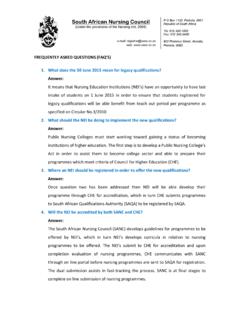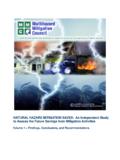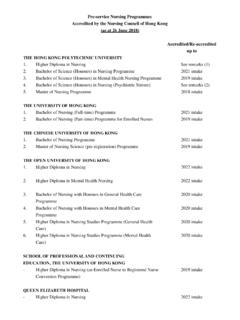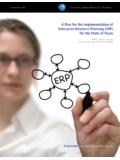Transcription of VitalStats - che.ac.za
1 VitalStats Public higher Education 2016 Public higher Education 2016 The council on higher Education (CHE) is an independent statutory body established by the higher Education Act, no. 101 of 1997 (amended). The CHE is the Quality council for higher Education, advises the Minister of higher Education and Training on all higher education issues and is responsible for quality assistance and promotion through the higher Education Quality Committee. Published by the council on higher Education in 2018 1 Quintin Brand Street Persequor Technopark Brummeria Pretoria South Africa +27 12 349 3840 council on higher Education, Pretoria, 2018 All rights reserved.
2 Material from this publication may be reproduced with the appropriate acknowledgement to the CHE. ISBN: 978-0-9947111-7-5 council ON higher EDUCATION VitalStats 2016 i Foreword This issue of VitalStats , Public higher Education, 2016 marks the seventh year of the council on higher Education (CHE) publishing this series. The series provides the latest audited data available on the higher education sector in an easy to use format. VitalStats 2016 contains data covering the period 2011 to 2016. Most of the graphs in the publication are based on data extracted from the higher Education Management Information System (HEMIS), and the CHE expresses appreciation to the Department of higher Education and Training (DHET) for collecting and extracting these data for use by the CHE and for providing the relevant financial and research data.
3 The CHE is also grateful to the National Student Financial Aid Scheme (NSFAS) for financial data and to Statistics South Africa for population data. As in previous issues, the first four sections of the publication cover student data, showing the size and shape of the sector with graphs indicating enrolments and numbers of graduates according to race; gender; qualification type; field of study; institutional type and other relevant categories. The fifth section of the publication (purple) provides data on staffing at public universities, broken down into various categories. The sixth section (blue) comprises cohort analyses of students that entered diploma, degree and postgraduate studies in 2011, tracking their throughput rates for particular qualification types.
4 Owing to the different regulation time associated with the mode of study (distance and often part-time) at the University of South Africa (UNISA), data for UNISA are considered separately in this section (as indicated on the relevant graphs). The CHE would like to thank Charles Sheppard for carrying out the cohort studies for this publication. The final section of VitalStats includes financial and research output data, with new graphs showing NSFAS allocations. The publication also includes a glossary based on HEMIS definitions and appendices listing the Classification of Educational Subject Matter or CESM categories; the various universities by institutional type; a description of the cohort analysis methodology and lists of the qualifications included in the analyses.
5 The role of the Monitoring and Evaluation Directorate staff, particularly Michael Gordon, in developing VitalStats is greatly appreciated. The CHE welcomes any feedback on this publication, which can be sent to Genevieve Simpson The publication can also be downloaded from the CHE s website ( ). Dr Denyse Webbstock Director: Monitoring and Evaluation council ON higher EDUCATION ii VitalStats 2016 Definitions Block grant: State subsidy to universities is divided into block and earmarked grants. Block grants are consolidated into a single transfer and the funds can be used for any legitimate university purpose. Currently block grants have four components: teaching input (based on enrolments), teaching output (based on graduations), research output (based on approved publications and research masters and doctoral graduations) and institutional factors (based on institution size and proportion of historically disadvantaged students).
6 Classification of Educational Subject Matter or CESM categories: A set of classifications aiming to provide a single coherent system for categorising subject matter irrespective of the level of instruction or type of institution. For a list of first-order CESM categories, see Appendix 2. Cohort: The first-time entry students in a given year who have enrolled for a particular higher education programme. Comprehensive Universities (Comp): This refers to institutions that offer the full spectrum of programmes, including vocational, professional and general formative programmes at both undergraduate and postgraduate levels. Contact mode of delivery: This refers to courses involving personal interaction with institutional teachers or institutional supervisors, through lectures, tutorials, seminars, practicals, supervision, or other forms of required work, which occurs at the institution s premises or at a site of delivery of the institution.
7 Course success rates: The success rate refers to the total number of courses passed by students in a given academic year relative to course enrolments. It is calculated by dividing the total number of FTE degree credits (courses completed) by FTE enrolments. These calculations, for a programme or for an institution as a whole, produce weighted average success rates. Distance mode of delivery: This refers to courses where the interaction with institutional teachers or institutional supervisors is undertaken remotely through the use of correspondence, telematics, or the internet. Earmarked funding: State subsidy to universities is divided into block and earmarked grants.
8 Earmarked funds must be spent on the purposes for which they are designated. In recent years, some of the categories for earmarked council ON higher EDUCATION VitalStats 2016 iii provision have been interest and redemption of government loans, infrastructure, teaching development, research development, foundation courses, clinical training of health professionals and veterinary science. Field of study: Enrolments are divided into four broad fields or areas of study, calculated by aggregating enrolments by CESM category as below. For a description of each CESM category, see Appendix 2: Science, Engineering and Technology (SET): CESM 01, 02, 06, 08, 09, 10, 13, 14, 15 & 16 Business & Commerce (B&C): CESM 04 Humanities (Hum): CESM 03, 05, 11, 12 ,17, 18, 19 & 20 Education (Ed): CESM 07 Full Cost of Study (FCS): The FCS is defined as the cost of registration, tuition, accommodation, books and meals as averaged per student per university.
9 Full-time equivalent (FTE): FTE student enrolments are calculated (a) by assigning to each course a fraction representing the weighting it has in the curriculum of a qualification, and (b) by multiplying the headcount enrolment of that course by this fraction. FTE staff numbers are calculated in a similar way. Gross Domestic Product (GDP): This is the total market value of all goods and services produced in a country in a given year. The GDP includes all consumer, investment and government economic activity during that year. The value of exports is added to GDP and the value of imports is subtracted. Headcount: The total number of students enrolled at each institution whether as full-time, part-time or occasional students.
10 National Student Financial Aid Scheme (NSFAS): NSFAS is the South African government student loan and bursary scheme which provides loans and bursaries to students at public universities and colleges. Nominal and real funding: Nominal funding refers to the actual amount of money given to a specific activity in Rand value for that specific year. Real funding relates the funding of a particular year relative to a base year, taking inflation into account. Real funding allows for a comparison of purchasing power over time as increases and decreases are compared to the base year. council ON higher EDUCATION iv VitalStats 2016 Occasional student: This is a person who satisfies the statutory requirements for entry into a formally approved qualification offered by the institution and who is effectively registered for an approved course, but who is not registered for an approved qualification.

















